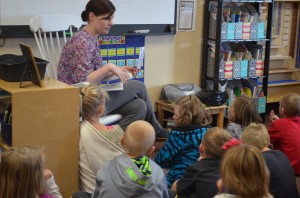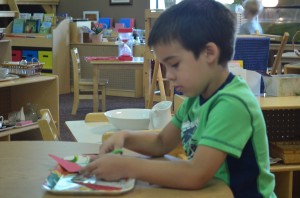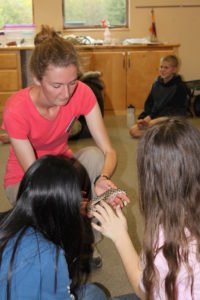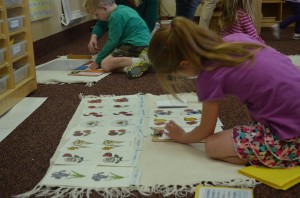Educational Program highlights:
- Montessori Method of Education
- Multi-age Grouping
- Environmental Education
 Montessori Method of Education: Montessori is a teaching methodology based on the natural learning processes of children. Dr. Maria Montessori, an Italian physician, developed the method more than 100 years ago. Dr. Montessori used the term ‘the absorbent mind’ to describe how a young child learns in a comfortable and stimulating environment. Within such an environment, a child becomes absorbed in work, developing concentration, independence, and self-discipline. (Lillard, Paula P. Montessori Today.) Dr. Montessori believed that children learn best through their senses. By working with concrete materials, the child begins to understand abstract concepts. With guidance from a trained Montessori teacher, the child gradually masters the different materials and concepts. As the child masters each task, it reinforces learning as a positive experience. Success develops the child’s self-confidence and self-esteem.
Montessori Method of Education: Montessori is a teaching methodology based on the natural learning processes of children. Dr. Maria Montessori, an Italian physician, developed the method more than 100 years ago. Dr. Montessori used the term ‘the absorbent mind’ to describe how a young child learns in a comfortable and stimulating environment. Within such an environment, a child becomes absorbed in work, developing concentration, independence, and self-discipline. (Lillard, Paula P. Montessori Today.) Dr. Montessori believed that children learn best through their senses. By working with concrete materials, the child begins to understand abstract concepts. With guidance from a trained Montessori teacher, the child gradually masters the different materials and concepts. As the child masters each task, it reinforces learning as a positive experience. Success develops the child’s self-confidence and self-esteem.
The approach has proven successful over the past 100 years to be effective in any culture and for all socioeconomic groups. As a result, the number of Montessori schools has expanded rapidly throughout the world in both public and private education. It is estimated that before 1985 approximately 750 private Montessori schools existed. No public schools had the Montessori program at that time. Since then, the number of private schools has expanded to 2,500 and 1,250 in public school systems throughout the U.S.
 Multi-age Grouping: Educational theory and research indicate that learning is an individual process. In time frame, style, and interests – and that children learn from one another. (Healy, Jane M. Endangered Minds. p.283; and Gardner, Howard. The Unschooled Mind. p. 11) Although most schools are organized by single age grouping, research has not found this to be beneficial. On the other hand, grouping by ability and age avoids the identification of slow students, improves relationships between students, and facilitates the use of common learning objectives and expectations. It improves peer culture, resulting in peer instruction, peer modeling, and peer reinforcement. (Brookover, W.B., L Beammer, H. Elthin – Creating Effective Schools. p. 11) Montessori education supports multi-age grouping, and Montessori teachers have implemented it for over 100 years. Montessori believed learning should occur in multi-age classrooms where children at various stages of development learn from and with each other. Her developmentally-appropriate approach was designed to fit each child instead of making each child fit the program. (Lillard, Paula P. Montessori Today.) Miller (1989) reviewed twenty-one studies of multi-grade classrooms. In terms of academic achievement, there were no significant differences between single-grade and multi-grade classes, but in terms of emotional factors, results favored the multi-grade classes. Students in multi-grade classes had more positive attitudes toward school and themselves and more positive social relationships. (Miller, Bruce –
Multi-age Grouping: Educational theory and research indicate that learning is an individual process. In time frame, style, and interests – and that children learn from one another. (Healy, Jane M. Endangered Minds. p.283; and Gardner, Howard. The Unschooled Mind. p. 11) Although most schools are organized by single age grouping, research has not found this to be beneficial. On the other hand, grouping by ability and age avoids the identification of slow students, improves relationships between students, and facilitates the use of common learning objectives and expectations. It improves peer culture, resulting in peer instruction, peer modeling, and peer reinforcement. (Brookover, W.B., L Beammer, H. Elthin – Creating Effective Schools. p. 11) Montessori education supports multi-age grouping, and Montessori teachers have implemented it for over 100 years. Montessori believed learning should occur in multi-age classrooms where children at various stages of development learn from and with each other. Her developmentally-appropriate approach was designed to fit each child instead of making each child fit the program. (Lillard, Paula P. Montessori Today.) Miller (1989) reviewed twenty-one studies of multi-grade classrooms. In terms of academic achievement, there were no significant differences between single-grade and multi-grade classes, but in terms of emotional factors, results favored the multi-grade classes. Students in multi-grade classes had more positive attitudes toward school and themselves and more positive social relationships. (Miller, Bruce –  Teaching and Learning in the Multigrade Classroom: Student Performance and Instructional Routines ERIC Digest.)
Teaching and Learning in the Multigrade Classroom: Student Performance and Instructional Routines ERIC Digest.)
Environmental Education: The goal of environmental education is to develop a world population that is aware of, and concerned about, the environment and its problems, and which knows, skills, attitudes, motivations, and commitment to work individually and collectively toward solutions to current problems and the prevention of new ones. (The Belgrade Charter ERIC Digest. p.2) Environmental education is not limited only to developing environmental awareness and appreciation. Using the school’s surroundings and community in which they live, local experiences help students learn within a personally meaningful environment, connecting place with self and community. (Woodhouse, Janice L. Place-Based Curriculum and Instruction: Outdoor and Environmental Education Approaches. ERIC Digest.)
Researchers have provided numerous examples of situations where in-the-environment learning was, or could be, more effective than about-the-environment learning in the classroom.
“Those things which can best be taught outdoors should there be taught.” – L.B. Sharp
 Montessori Method of Education (Curriculum)
Montessori Method of Education (Curriculum)
The Montessori curriculum is interdisciplinary subjects that are studied together, not in isolation. This integrated curriculum offers the child learning opportunities which result in a strong foundation in the Core subject areas. Language Arts (reading, spelling, vocabulary, grammar, handwriting, and creative writing), Social Studies (history, geography, and cultures), Science, and Math. It is worth noting that while the division of the world into these separate “subjects” is perhaps a convenient way to write about our work at school, it is not the way children experience it. The curriculum complies with all expectations regarding Minnesota’s Academic Standards.
The Montessori classroom allows children to take responsibility for their education in a “prepared environment.” Within a framework of order, children are free to choose the activities that will assist them in their process of self-construction. The classroom contains self-correcting, sequenced Montessori materials.